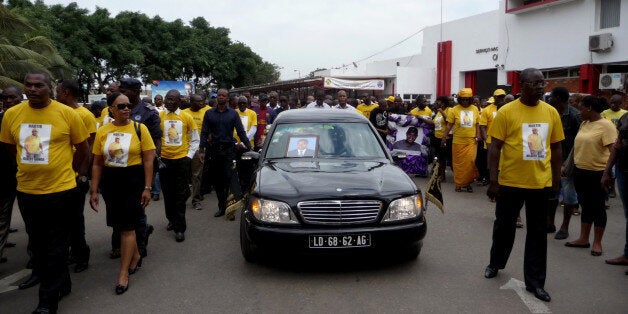
Unsurprisingly the human rights situation in Angola is not a subject many people will know much about. But over the last month, the hunger strike of a 33-year-old rapper and political activist, Luaty Beirão, has been making news around the world. This week, as he embarked on his second month without food, concerns are growing that his condition may be critical.
Beirão was arrested on June 20 with a group of activists in the country's capital, Luanda, after they gathered to discuss politics. He and 14 others have been detained ever since without trial and in September they were charged with preparing a "preparing acts pursuant to a coup d'etat". On 20 September Beirão began a hunger strike.
On October 9, Beirão was transferred to a prison hospital and then onto a private clinic where he agreed to receive saline solution intravenously but his condition is said to be deteriorating. As concerns for his health increase, so does the international outcry demonstrating that the hunger strike, a most ancient form of protest, has lost none of its power.
While most people think the hunger strike as a twentieth century phenomena - employed most famously in the struggles for women's suffrage and the Irish and Indian independence movements - the practice is in fact rooted far further back in history. Hunger strikes were practiced in medieval Ireland, ancient India and by the Romans. Even the young Tiberius is said to have staged a hunger strike to persuade his uncle, Augustus Caesar, to allow him to travel to Rhodes. Tiberius only fasted for four days but in AD 25 Rome, protesting at the curtailment of freedom of speech, Cremutius Cordus fasted to death.
The hunger strike has traditionally been used as a means of passive resistance to perceived injustices when few other political opportunities exist, its power lying in the striker's preparedness to die for their cause. Through the politicization of their body the hunger striker, who is often without a voice, is able to convey a message and influence the powerful.
Indeed, the eloquence of the hunger strike lies in its ability to reconfigure the power dynamic between the powerless and the powerful. By starving themselves slowly the hunger striker makes public the very private act of dying and their suffering becomes a source of strength eliciting strong emotions among supporters and observers.
A hunger strike is defined as the voluntary refusal of food and/or fluids. The length of time a hunger strike can last will depend on faster's body fat, physical health and striking strategy. If the striker refuses fluids they will not survive for much more than a week. If they take fluids, sugar and/or salt, they can prolong their hunger strike for much longer. Bobby Sands, a fit 27 year-old survived for 66 days and Gandhi fasted for 21 days whilst in his 70s and with hardly any body fat. The longest recorded sugared-water hunger strike before death was 94 days, by an Irish Republican in the 1920's. If the striker takes vitamins as well as sugar and salt like some of the more recent prison hunger strikers in Turkey, death can take an agonising 300 days.
Anyone who has seen Hunger, Steve McQueen's 2008 film about the Maze prison hunger strike will have some idea of just how horrific is starvation as a way to die. The body literally consumes itself. After about three days the liver starts to break down body fat in a process called ketosis. The body slows its metabolism to compensate but after about three weeks starts 'mine' its muscles and vital organs for energy. Ketosis results in the production of toxic ketone bodies which can be excreted through urine, oxidized by the brain or even expelled through the lungs but ultimately cause a potentially lethal condition called ketoacidosis. Death comes by dehydration, atrophication and the painful failure of internal organs, chiefly kidneys and liver.
The exact origin of the hunger strike is unclear but it has been used a political tactic around the world for many centuries. In medieval Ireland, where hunger strikes were actually encoded in civic law, it was common practice for people to fast on the doorstep of someone they felt had committed them an injustice. If the hunger striker was permitted to die, the person on whose doorstep the faster had died would be held responsible for the death and liable to compensate the deceased's family.
Hunger strikes were also practiced by many members of the clergy and according to legend, even Ireland's patron saint, St Patrick, went on a hunger strike against God. After forty-five days, so the story goes, God eventually backed down. In ancient India, hunger protests were also staged outside the doors of those who strikers felt had committed an offense against them, typically debtors. The practice know as "sitting dharna", dates back to at least 400 - 750 BC where it appears in the ancient Sanskrit epic the Ramayana, and was only abolished by law in 1861.
These ancient Irish and Indian hunger striking traditions had their modern-day apotheoses in the Irish Republican movement and the Indian struggle for independence. In Ireland the tactic exploded in popularity after the 1916 Easter Rising. In 1917 Thomas Ash, an Irish Republican prisoner calling for political prisoner status, died after being force fed. In 1920, the Lord Mayor of Cork Terence MacSwiney's hunger strike attracted worldwide interest. When he died after 73 days without food, 40,000 people turned out to watch his funeral cortege and even the Pope sent a blessing. After the end of the Irish Civil War in 1923, over 8,000 IRA prisoners opposed to the 1921 Anglo-Irish Treaty went on hunger strike. In the 1940's hundreds of hunger strikes took place and in the 1970's the Provisional IRA revived the tactic. But it was the Maze Prison strike of 1981 in which Bobby Sands along with nine other inmates fasted to death, that stands out in the memory.
Sands and the Blanketmen, as they were known, went on hunger strike after the British government had reneged on a deal to restore their political prisoner status. Rather than many prisoners striking at the same time, the strike was run on a rolling basis, each hunger striker starting his fast a week after the other in order in order to maximise publicity. Four days after Sands, the leader of the strike, had first refused food the local MP for Fermanagh & South Tyrone died forcing a By-election. Sinn Fein nominated Sands for the seat and his victory, drew world-wide attention. Despite his death, Sands became a powerful symbolic figure in the struggle for a united Ireland and at the time the New York Times recorded that Sands had "bested an implacable British Prime Minister [Margaret Thatcher]."
In India, Mahatma Gandhi staged 17 hunger strikes in the 1920's, 30's and 40's. Whilst most of these were directed against British colonial rule, his 1948 hunger strike aimed at stopping the bloody inter-religious violence that followed partition. Announcing that he would not eat until the violence stopped, he is largely credited for ending the fighting. Gandhi was imprisoned by the British in 1922, 1930, 1933 and in 1942 and on each occasion staged a hunger strike. Gandhi's 1932 fast calling for the improvement of the lives of the Dalits (Untouchables) resulted in meaningful policy changes after just six days of fasting. Although the British Government ceded to many of his demands records declassified in 2006 show that Winston Churchill had opposed these concessions and favored a strategy of letting Gandhi die in prison.
Both the Irish Republicans and Gandhi took much inspiration from the Suffragettes who, in the early 20th century used hunger strikes as part of their struggle for female suffrage. Fearful of losing control, prison authorities introduced a brutal system of force feeding which involved inserting a rubber tube up the nose or down the throat and into the stomach. For the latter method a steel hoop was pushed into the mouth and screwed open as wide as possible. If the tube was accidentally inserted into the windpipe, food would enter the lungs and could be fatal. Indeed several women died as a result of force-feeding and Sylvia Pankhurst describing the aftermath of oral forced feeding wrote that her gums were, "always sore and bleeding, with bits of loose, jagged flesh".
In 1913, the passage of the Prisoner Temporary Discharge of Ill Health Act, nicknamed the "Cat and Mouse Act," meant that hunger strikers were released when they became sick and rearrested as soon as they had recovered sufficiently. This process often extended the period of the sentence and some women were force fed more than 200 times as a result. American suffragettes also used hunger strikes and, as in Britain, they were subjected to brutal treatment while in prison, including force feeding.
The world's longest and most deadly hunger strike began 15 years ago but is not widely internationally known. It started in Turkey in 2000 involving political prisoners across the country and lasted for over two years resulting in over 100 deaths and around 400 unrecoverable diseases. Taking their inspiration from the Maze hunger strikers the Turkish hunger strikers used a collective system of rolling hunger strike that bases its power on numbers of participants rather than length of a single individual's fast.
The hunger strikes by the 'unlawful combatants' in Guantánamo Bay detention camp have received more attention, but due to restricted media access, the coverage has been patchy and the details unclear. In 2005 there were two hunger strikes in the detention centre. US Army officials claim that 50 detainees were involved in the first hunger strike, and 76 detainees involved in the second however human rights activists estimate the numbers to be closer to 150 and 200 participants.
Over the centuries the hunger strike has evolved from a method for individuals to highlight claims against each other, to an effective means of political and social change. The hunger strike may have reached its apogee in the twentieth century, helping to conquer age-old prejudices, expose injustices and even and overcome mighty empires but Beirão's hunger strike in Angola shows that it has lost none of its potency.
Gandhi, wrote in his Letters to a Disciple, that "[u]nder certain circumstances, fasting is the one weapon God has given us for use in times of utter helplessness." Whilst Beirão's situation might not have been one of utter helplessness, he has nevertheless used this weapon to challenge a government, accustomed to using repressive methods to suppress dissent.
In one of his songs Beirão says of the government, "If we poke them in the eye, they'll be the architect of your funeral". Hopefully the Angola government will bend to international pressure and this lyric will not turn out to be a prophetic one.
This article is based on a piece first published in the Contemporary Review
